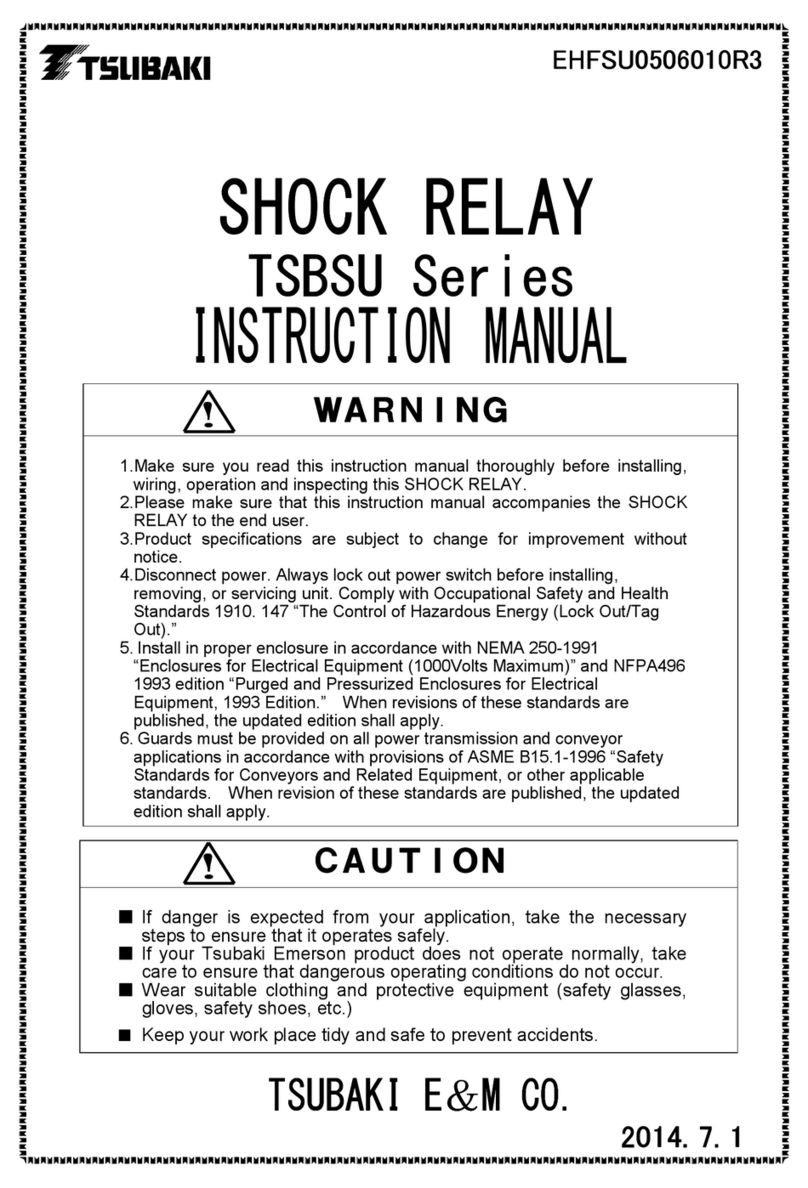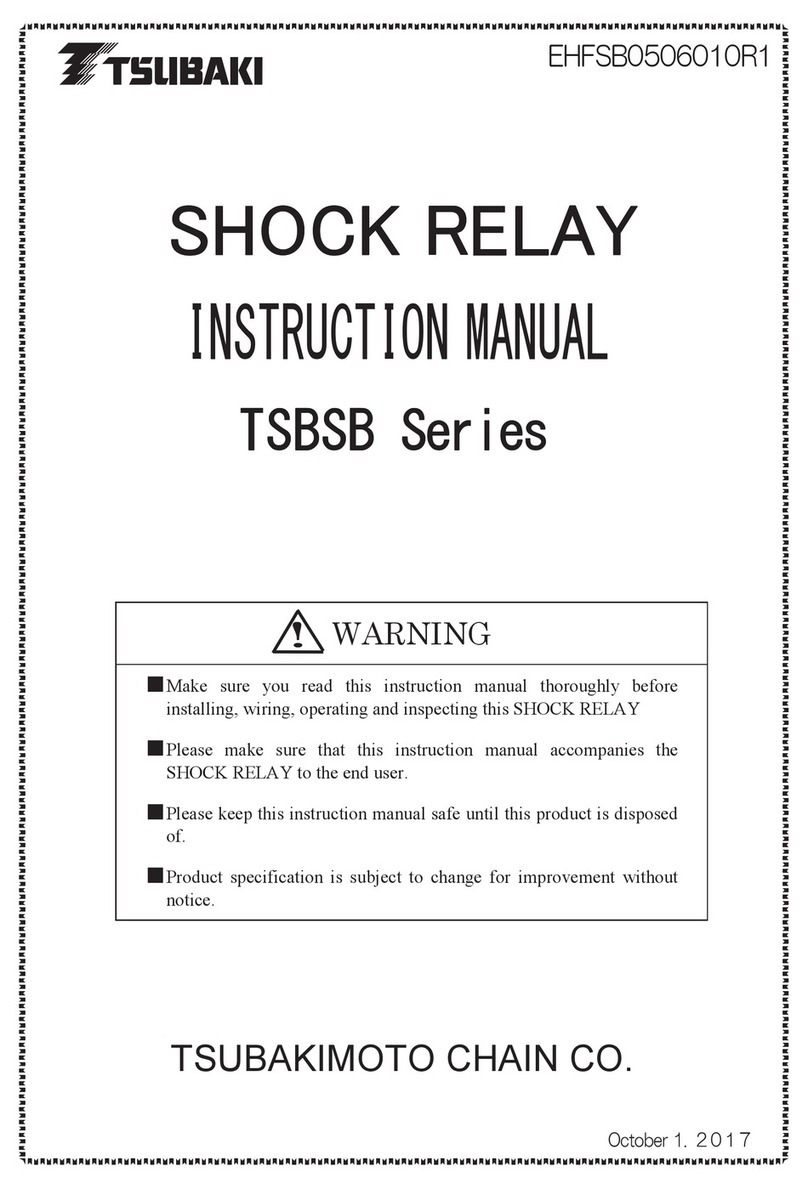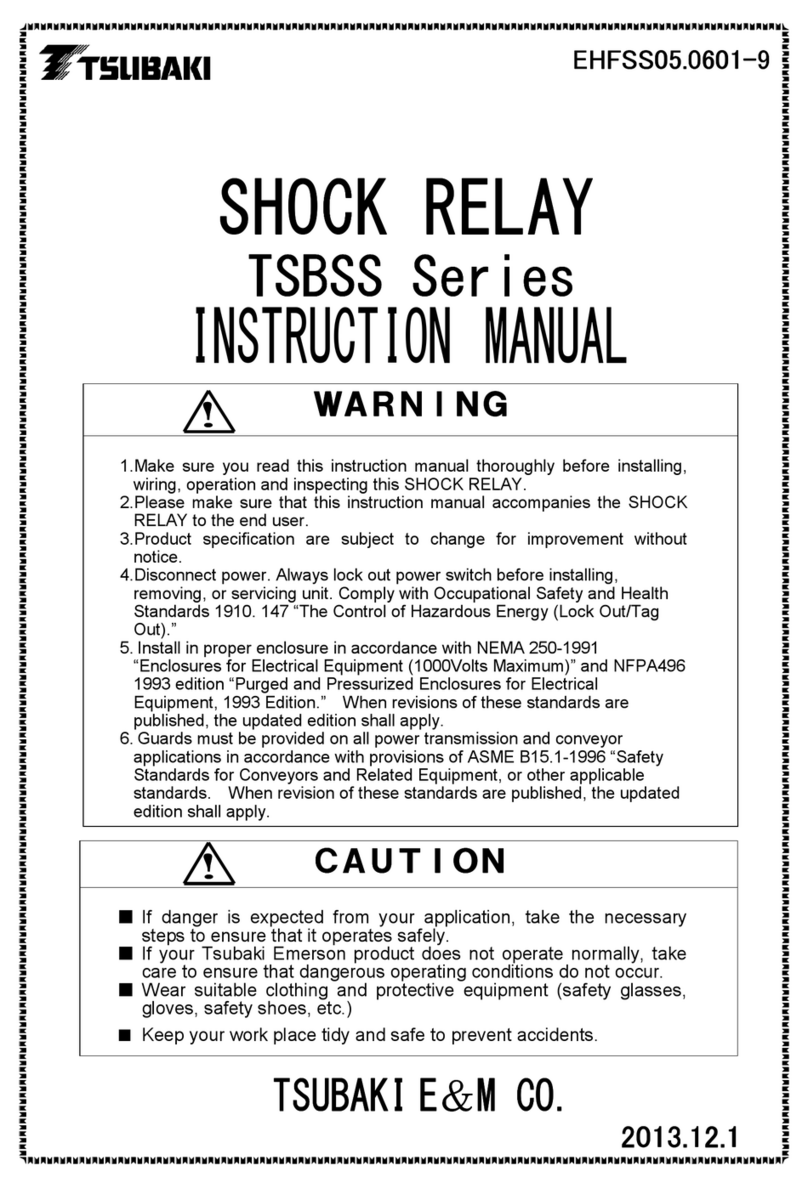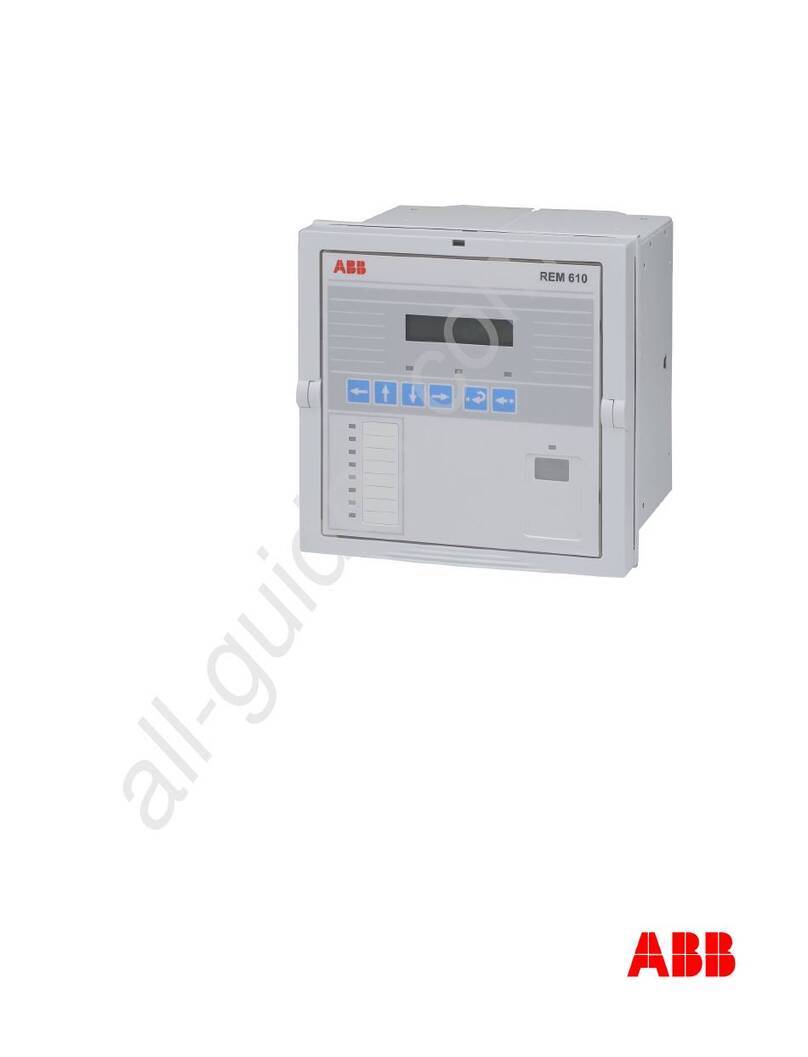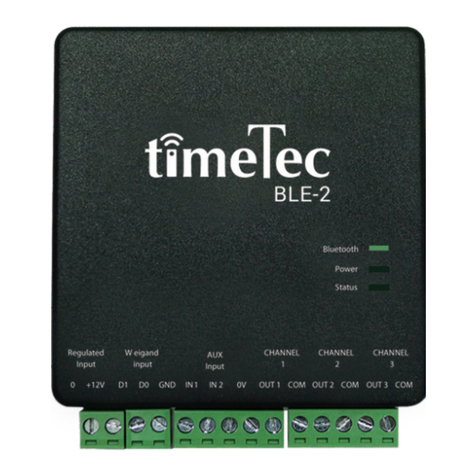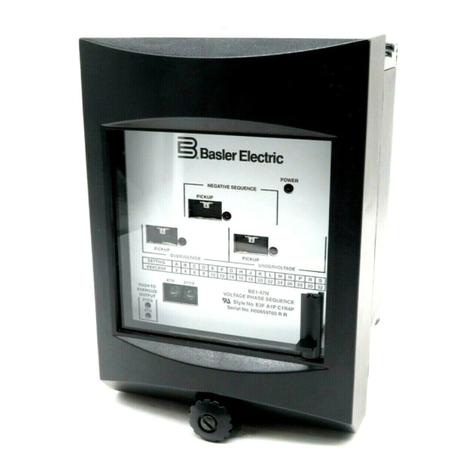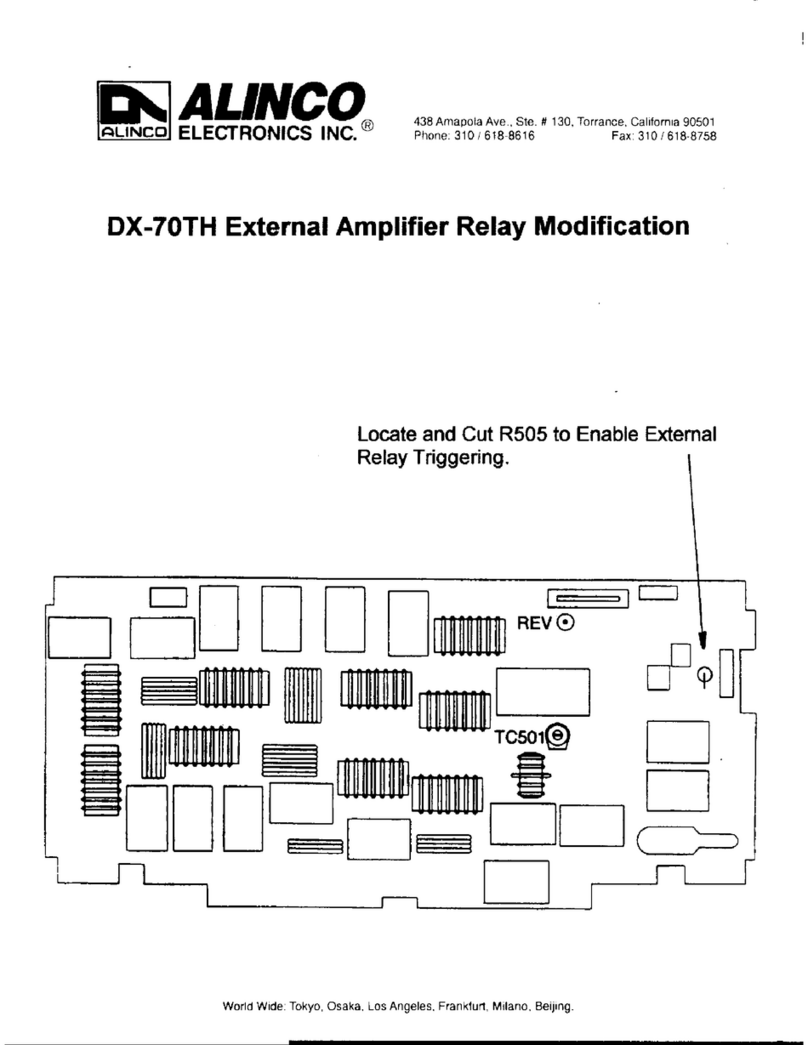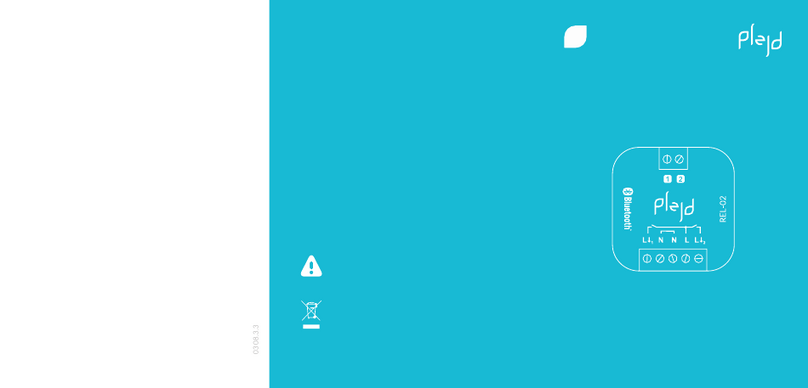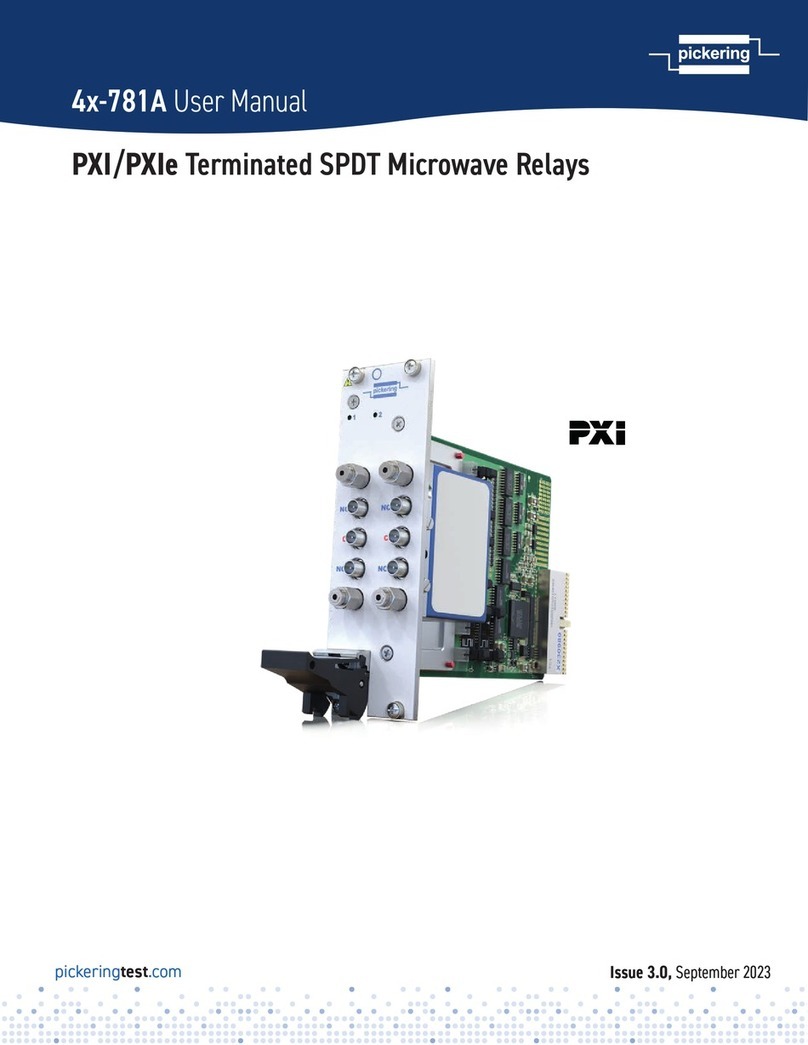Tsubaki TSBED Series User manual

㻿㻿㻴㻻㻯㻷㻌㻾㻱㻸㻭㼅㻌㻌
76%('6HULHV
㻱㻱㻴㻲㻱㻰㻜㻜㻞㻜㻜㻢㻜㻝㻜㻜㻾㻝
1EVQDGT
ᲬᲪᲫᲱ
,16758&7,21
0$18$/
7768%$.,00272&+$,1
&&2
WARNING
㻌
ڦ
Make sure you read this instruction manual thoroughly before
installing, wiring, operating and inspecting this SHOCK
RELAY
ڦ
Please make sure that this instruction manual accompanies the
SHOCK RELAY to the end user.
ڦPlease keep this instruction ma
nual safe until this product is
disposed of.
ڦ
Product specification is subject to change for improvement
without notice.㻌
ᵲᵱᵠᵎᵐᵎᵣᵢᴾ
ᵲᵱᵠᵎᵕᵓᵣᵢᴾ
ᵲᵱᵠᵐᵐᵎᵣᵢᴾ
ᵲᵱᵠᵓᵓᵎᵣᵢᴾ

䠉㻌 1㻌䠉
㻌
1
䠊
Preface
Thank you for purchasing the Shock Relay TSBSB series.
The Shock Relay is a current monitoring device that㻌quickly detects motor overload,
thus protecting your equipment from costly damage.
This instruction manual describes everything from installation to adjustment. Be
sure to read this manual carefully before using your Shock Relay.
2
䠊
Safety precaution
●Please read this instruction manual thoroughly before using this Shock Relay.
●Familiarize yourself with all of the knowledge of the devices, safety information,
and precautions before using the Shock Relay.
●After reading this manual, be sure to keep it in a place where users can access any
time.
●In this instruction manual, the rank of safety requirements is divided into
WARNING and CAUTION.
ᴾᴾᴾᴾᴾᴾ
ᴾᴾᴾ
Death or serious injury may result from product misuse
due to not following the instructions.
ᴾ ᴾ ᴾ ᴾ
Minor or moderate injury, as well as damage to the
product may result from product misuse due t
o not
following the instructions.
Even if the instructions are followed, a serious consequence may result depending
on the situation.
Be sure to exercise due caution and follow all of these important instructions.
CONTENTS
1. Preface …………………………
2. Safety precaution………..
…....
3. Checking the package …………
4. Dimensions...
…………………..
5.㻌Specifications…………………
.
6. Storage ………………..…
.......
7. Installation …………………
..
8.㻌Wiring ………………………
..
9. Wiring diagram ...……………
.
10. Function ...……………………......
11. LED display
.………………………..
12. Set up
……………..…..…..
...........
13. Troubleshooting .....…...…..….…
.…
14.
Reset procedure for trip operation…
15. Maintenance..........…......…..…
..…
16. Daily Inspection ………..……..
.…..
17. Periodic check
………………………
18. Warranty…
…………………….……
1
1
2
3
4
5
5
6
7
Page
Page
8
10
12
12
13
13
13
13
14
WARNING
㸟
㸟
CAUTION

䠉㻌 2㻌䠉
ᴾ
ᴾ
WARNING
●Follow safety related rules and regulations. (Ordinance on Industrial Safety and Health, etc.)
●In the case of installation, removal, maintenance, please follow the below requirements.
(1)Power off.
(2)To avoid falling accident, do not stand under the device.
(3)Tighten moving parts.
(4)Wear proper work clothes and protective equipment.
●When carrying out operation test or periodic inspection, make sure protective device functions
properly.
●Megger testing is conditional, must be performed in accordance with instruction manual.
●Never operate under the live wire condition, power off before starting operation.
Electric Shock Risk.
●The wiring, operation, maintenance, check of Shock Relay must be performed by workers with
expertise.
Electric Shock, Injury, Fire Risk.
㻌 㻌 㻌 㻌
CAUTION
●In case the instruction manual is not available, request to furnish one from the distributor or our
sales office.
●Do not recompose or rebuild parts or units.
●Consumable parts (condenser, relay, etc.) are built in the products. Function chec
k should be
performed periodically. In the case of malfunction, contact the distributor for repair.
●Avoid usage in the corrosive gas environment. Sulfide gases (SO2, H2
S) corrode cooper and cooper
alloy used on PCBs and parts and cause the malfunction.
●Dirt and dust may result in overheat and fire, should be cleaned periodically.
●Products must be discarded in accordance with industrial waste rules.㻌
㸟
㸟

䠉㻌 3㻌䠉
3䠊
䠊
Checking the package
Upon receiving the Shock Relay, please check the following:
䐟Check whether the model and specification conform to what you ordered.
䐠Check to see no damages occurred during the delivery.
䐡Package: Shock Relay, Instruction Manual
䠘Model Identification䠚
ᵲᵱᵠᴾᵎᵐᵎᴾᵣᵢ
4. Demensions
Maximum Motor Capacity (class 200V )
020 0.2kW
075 0.75kW
220 2.2kW
550 5.5kW
ED series
SHOCK RELAY
Cover
Mounting hole
Screw

䠉㻌 4㻌䠉
5. Specifications
㻹㼛㼐㼑㼘㻌㻺㼛㻚㻌 㼀
㼀㻿㻮㻜㻞㻜㻱㻰
㻌
㼀㻿㻮㻜㻣㻡㻱㻰
㻌
㼀㻿㻮㻞㻞㻜㻱㻰
㻌
㼀㻿㻮㻡㻡㻜㻱㻰
㻌
㻭㼜㼜㼘㼕㼑㼐㻌
㼙㼛㼠㼛㼞
㻌
㻌
㻞㻜㻜㼂
㻌
㻰㼕㼜㻌
㻿㼣㼕㼠㼏㼔㻌
㼀㻞㻌
䠌䠊䠍䡇䠳㻌 䠌䠊䠐䡇䠳㻌 䠍䠊䠑䡇䠳㻌 䠏䠊䠓䡇䠳㻌
㼀㻝㻌
䠌䠊䠎䡇䠳㻌 䠌䠊䠓䠑䡇䠳㻌 䠎䠊䠎䡇䠳㻌 䠑䠊䠑䡇䠳㻌
㻠㻜㻜㼂
㻌
㼀㻞㻌
䠌䠊䠍䠈䠌䠊䠎䡇䠳
㻌
䠉㻌 䠎䠊䠎䠈䠏䠊䠓䡇䠳
㻌
䠓䠊䠑䡇䠳㻌
㼀㻝㻌
䠌䠊䠐䠈䠌䠊䠓䠑䡇䠳
㻌
䠍䠊䠑䡇䠳㻌 䠑䠊䠑䡇䠳㻌 䠍䠍䡇䠳㻌
㻰㼑㼠㼑㼏㼠㼑㼐㻌㻲㼞㼑㼝㼡㼑㼚㼏㼥㻌
䠎䠌䡚䠎䠌䠌䠤䡖㻌
㻹㼍㼤㼕㼙㼡㼙㻌㼂㼛㼘㼠㼍㼓㼑㻌
䠝䠟䠒䠌䠌䠲㻌 㻌 䠑䠌䠋䠒䠌㻴㼦㻌
㻯㼛㼚㼠㼞㼛㼘㻌㻼㼛㼣㼑㼞㻌㼟㼛㼡㼞㼏㼑㻌
䠎䠐㻌 䡚㻌 䠎䠐䠌䠲䠝㻯㻛䠠䠟㼼䠍䠌䠂䠈䠑䠌䠋䠒䠌䠤䡖㻌
㻯㼡㼞㼞㼑㼚㼠㻌
㼟㼑㼠㼠㼕㼚㼓㻌
㻰㼕㼜㻌
㻿㼣㼕㼠㼏㼔㻌
㼀㻞㻌
䠌䠊䠎䠌䡚䠍䠊䠎䠌䠝
㻌
䠄㻮㼅㻌㻜㻚㻜㻝㻭䠅㻌
䠍䠊䠎䠌䡚䠏䠊䠎䠌㻭
㻌
䠄㻮㼅㻌㻜㻚㻜㻞㻭䠅㻌
䠏䠊䠌䠌䡚䠍䠌䠊䠌䠝
㻌
䠄㻮㼅㻌㻝㻭䠅㻌
䠒䠊䠌䠌䡚䠎䠒䠊䠌䠝
㻌
䠄㻮㼅㻌㻜㻚㻞㻭䠅㻌
㼀㻝㻌
䠌䠊䠐䠌䡚䠎䠊䠐䠌㻭
㻌
䠄㻮㼅㻌㻜㻚㻜㻞㻭䠅㻌
䠍䠊䠔䠌䡚䠑䠊䠔䠌䠝
㻌
䠄㻮㼅㻌㻜㻚㻜㻠㻭䠅㻌
䠐䠊䠌䠌䡚䠍䠐䠊䠌䠝
㻌
䠄㻮㼅㻌㻜㻚㻝㻭䠅㻌
䠕䠊䠌䠌䡚䠏䠐䠊䠌䠝
㻌
䠄㻮㼅㻌㻜㻚㻞㻡㻭䠅㻌
㻿㼠㼍㼞㼠㻌㼠㼕㼙㼑㻌㼟㼑㼠㼠㼕㼚㼓㻌
䠌䠊䠎㻌 䡚㻌 䠍䠌䠊䠌䡏㻌 㻔㻮㼅㻌㻜㻚㻞㼟㻕㻌
㻿㼔㼛㼏㼗㻌㼠㼕㼙㼑㻌㼟㼑㼠㼠㼕㼚㼓㻌
䠌䠊䠎㻌 䡚㻌 䠑䠊䠌䡏㻌 㻔㻮㼅㻌㻜㻚㻞㼟㻕㻌
㻯㼡㼞㼞㼑㼚㼠㻌㻭㼏㼏㼡㼞㼍㼏㼥㻌
㼼䠑䠂㼼䠍㼐㼕㼓㼕㼠㻌㼘㼑㼟㼟䠄㻌 㻵㼚㻌㼏㼍㼟㼑㻌㼛㼒㻌㼡㼟㼕㼚㼓㻌㻵㼚㼢㼑㼞㼠㼑㼞㻌 㼼䠍䠌䠂㼼䠍㼐㼕㼓㼕㼠䠅㻌
㼀㼕㼙㼑㻌㻭㼏㼏㼡㼞㼍㼏㼥㻌
㼼䠑䠂㼼䠍㼐㼕㼓㼕㼠㻌㼘㼑㼟㼟㻌
㻼㼞㼛㼠㼑㼏㼠㼕㼢㼑㻌㻸㼛㼏㼗㼑㼐㻌㻹㼛㼠㼛㼞
㻌
㼀㼔㼑㻌㼞㼑㼘㼍㼥㻌㼣㼕㼘㼘㻌㼎㼑㻌㼠㼞㼕㼜㼜㼑㼐㻌㼍㼒㼠㼑㼞㻌㼠㼔㼑㻌㼟㼡㼙㻌㼛㼒㻌
㼟㼠㼍㼞㼠㻌㼠㼕㼙㼑㻌㼍㼚㼐㻌㻜㻚㻞㼟㻌㼎㼥㻌㼟㼠㼍㼘㼘㻌
㼣㼔㼑㼚㻌㼠㼔㼑㻌㼏㼡㼞㼞㼑㼚㼠㻌㼙㼛㼞㼑㻌㼠㼔㼍㼚㻌㻞㻜㻜㻑㻌㼛㼒㻌㼏㼡㼞㼞㼑㼚㼠㻌㼟㼑㼠㼠㼕㼚㼓㻌
㻾㼑㼘㼍㼥㻌
㻯㼛㼚㼠㼍㼏㼠㻌㻾㼍㼠㼕㼚㼓㻔㼙㼍㼤㻚㻕㻌
䠏䠝䠈䠎䠑䠌䠲䠝䠟㻌 䠄䠿䡋䡏䃥䠙䠍䠅㻌
㻯㼛㼚㼠㼍㼏㼠㻌㻾㼍㼠㼕㼚㼓㻔㼙㼕㼚㻚㻕㻌
䠠䠟䠎䠐䠲䚸䠐䡉䠝㻌
㻸㼕㼒㼑㻌
㻤㻜㻘㻜㻜㻜㻌㼍㼠㻌㼞㼍㼠㼑㼐㻌㼘㼛㼍㼐㻌
㻹㼛㼐㼑㻌
䠍䠽䠍䠾㻌
㻻㼜㼑㼞㼍㼠㼕㼛㼚㻌
㻺㼛㼞㼙㼍㼘㼘㼥㻌㼐㼑㻙㼑㼚㼑㼞㼓㼕㼦㼑㼐㻌
㻾㼑㼟㼑㼠㻌
䠝䠖䠝䠱䠰㻌
㻭㼡㼠㼛㼙㼍㼠㼕㼏㻌㼞㼑㼟㼑㼠㻌㼕㼚㻌㻝㻌㼟㼑㼏㼛㼚㼐㻌㼍㼒㼠㼑㼞㻌㼠㼔㼑㻌㼠㼞㼕㼜㻌
䠩䠖䠩䠝䠪㻌
㻹㼍㼚㼡㼍㼘㻌㼞㼑㼟㼑㼠㻌㼎㼥㻌㻯㼔㼑㼏㼗㻛㻾㼑㼟㼑㼠㻌㼎㼡㼠㼠㼛㼚㻌
㻵㼚㼟㼡㼘㼍㼠㼕㼛㼚
㻌
㻮㼑㼠㼣㼑㼑㼚㻌 㼏㼍㼟㼕㼚㼓㻌
㼍㼚㼐㻌㼏㼕㼞㼏㼡㼕㼠㻌 䠠䠟䠑䠌䠌䠲䠍䠌䠩䃈㻌
㻰㼕㼑㼘㼑㼏㼠㼞㼕㼏
㻌
㻿㼠㼞㼑㼚㼓㼠㼔㻌
㻮㼑㼠㼣㼑㼑㼚㻌 㼏㼍㼟㼕㼚㼓㻌
㼍㼚㼐㻌㼏㼕㼞㼏㼡㼕㼠
㻌
䠎䠌䠌䠌䠲䠝䠟㻌 䠒䠌㻴㼦㻌 䠍㼙㼕㼚㻌
㻮㼑㼠㼣㼑㼑㼚㻌
㼏㼛㼚㼠㼍㼏㼠㼟
㻌
䠍䠌䠌䠌䠲䠝䠟㻌 䠒䠌㻴㼦㻌 䠍㼙㼕㼚㻌
㻱㼚㼢㼕㼞㼛㼚㼙
㼑㼚㼠㻌
㻵㼚㼟㼠㼍㼘㼘㼍㼠㼕㼛㼚㻌
㻰㼛㻌㼚㼛㼠㻌㼕㼚㼟㼠㼍㼘㼘㻌㼕㼚㻌㼍㻌㼐㼡㼟㼠㼥㻌㼘㼛㼏㼍㼠㼕㼛㼚㻌㼛㼞㻌㼑㼤㼜㼛㼟㼑㻌㼠㼛㻌㼏㼛㼞㼞㼛㼟㼕㼢㼑㻌
㼓㼍㼟㼟㼑㼟㻘㻌㼛㼕㼘㻌㼟㼜㼘㼍㼟㼔㼑㼟㻌㼛㼞㻌㼐㼕㼞㼑㼏㼠㻌㼟㼡㼚㼘㼕㼓㼔㼠㻌㼛㼞㻌㼛㼡㼠㻙㼐㼛㼛㼞㻌
㼀㼑㼙㼜㼑㼞㼍㼠㼡㼞㼑㻌
䠉䠎䠌䡚䠇䠒䠌䉝㻌
㻴㼡㼙㼕㼐㼕㼠㼥㻌
䠏䠌䡚䠔䠑䠂䠮䠤䠄㼚㼛㼚㻙㼏㼛㼚㼐㼑㼚㼟㼕㼚㼓䠅㻌
㻭㼘㼠㼕㼠㼡㼐㼑㻌 䠍䠌䠌䠌䡉㻌 㼛㼞㻌㼘㼑㼟㼟㻌
㻼㼛㼣㼑㼞㻌㻯㼛㼚㼟㼡㼙㼜㼠㼕㼛㼚㻌
䠎䠊䠌䠳㻌 㼛㼞㻌㼘㼑㼟㼟㻌
㻹㼍㼟㼟㻌
䠌䠊䠎䠑䡇䡃㻌 㼛㼞㻌㼘㼑㼟㼟㻌
㻖㻝㻚㻌㼀㼔㼑㻌㼍㼜㼜㼘㼕㼏㼍㼎㼘㼑㻌㼙㼛㼠㼛㼞㼟㻌㼍㼞㼑㻌㼖㼡㼟㼠㻌㼍㻌㼞㼛㼡㼓㼔㻌㼕㼚㼐㼕㼏㼍㼠㼕㼛㼚㻌㼒㼛㼞㻌㼞㼑㼒㼑㼞㼑㼚㼏㼑㻚㻌㻹㼍㼗㼑㻌㼥㼛㼡㼞㻌㼟㼑㼘㼑㼏㼠㼕㼛㼚㻌㼎㼍㼟㼑㼐㻌
㼡㼜㼛㼚㻌 㼍㼏㼠㼡㼍㼘㻌 㼑㼘㼑㼏㼠㼞㼕㼏㼍㼘㻌 㼏㼡㼞㼞㼑㼚㼠㻌 㼢㼍㼘㼡㼑㻚㻌 㻿㼑㼘㼑㼏㼠㻌 㼎㼥㻌 㼑㼘㼑㼏㼠㼞㼕㼏㼍㼘㻌 㼏㼡㼞㼞㼑㼚㼠㻌 㼢㼍㼘㼡㼑㻌 㼒㼛㼞㻌 㼟㼕㼚㼓㼘㼑㻙㼜㼔㼍㼟㼑㻌
㼙㼛㼠㼛㼞㼟㻌㼍㼟㻌㼣㼑㼘㼘㻚㻌
㻖㻞㻚㻌 㻿㼑㼠㻌 㼢㼍㼘㼡㼑㼟㻌 㻝㻜㻭㻌 㼍㼚㼐㻌 㼔㼕㼓㼔㼑㼞㻌 㼍㼞㼑㻌 㼐㼕㼟㼜㼘㼍㼥㼑㼐㻌 㼍㼟㻌 㼐㼑㼟㼏㼞㼕㼎㼑㼐㻌 㼛㼚㻌 㼠㼔㼑㻌㼞㼕㼓㼔㼠㻌㼐㼡㼑㻌㼠㼛㻌㼍㻌㼙㼍㼤㼕㼙㼡㼙㻌
㼚㼡㼙㼎㼑㼞㻌㼛㼒㻌㼐㼕㼟㼜㼘㼍㼥㻌㼐㼕㼓㼕㼠㼟㻚㻌㻝㻜㻚㻜㻭䊻㻝㻜㻚㻞㻭䊻㻝㻜㻚㻡㻭䊻㻝㻜㻚㻣㻭䊻㻝㻝㻚㻜㻭㻌
㻖㻟㻚㻌㻯㼑㼞㼠㼕㼒㼕㼏㼍㼠㼑㻌㼟㼠㼍㼚㼐㼍㼞㼐㻌㻦㻌㼁㻸㻌㼏㼑㼞㼠㼕㼒㼕㼏㼍㼠㼕㼛㼚㻌䇵㻌㼁㻸㻡㻜㻤㻘㻌㻯㻯㻯㻌㼏㼑㼞㼠㼕㼒㼕㼏㼍㼠㼕㼛㼚㻌䇵㻌㻳㻮㻝㻠㻜㻤㻠㻚㻠㻌

䠉㻌 5㻌䠉
6. Storage
㻌㻌
CAUTION
●Storage shock relay on condition of temperature -30
to +70 Υ, no con
densation, freeze, oil mist,
corrosive gases, and dust
If you do not comply with the above storage environment, Shock Relay may not
function properly
7. Installation
㸵㸬㸯 Environment
㻌㻌 Install Shock Relay in the following environment.
CAUT
ION
●Keep Shock Relay free from lint, paper, wooden chips,
dirt, dust, metal scrap, etc.
㻌
㻌
Fire, Accident Risk
CAUTION
●Avoid usage in the corrosive gas environment. Sulfide
gases (SO
2, H2
S) corrode cooper and cooper alloy used on
PCBs and parts and cause
the malfunction.
㸵㸬㸰 Install with Screw
Pull the attachment on the Shock Relay in the direction of the arrow as shown the
figure ( ).
-
㸵㸬㸱 Installation of DIN rail
Pull the hook on the Shock Relay in the direction of the arrow as shown the figure
().
Hook
Attachment
Hole
㸟
㸟
㸟

䠉㻌 6㻌䠉
8. Wiring
5.1Explanation of the Terminals
(1) Connect to a commercial power supply. Never mistake the voltage of the control
power source. If device with harmonic noise, such as inverter is used, install an
isolation transformer.
(2) When connecting without crimp terminal, tightening torque of 0.4~0.6N䞉m(䈜) is
recommended to avoid screw damage.
Terminal block specification: M3.5 screw, tightening torque䠖0.8~1.2N䞉m㻌
䈜tightening torque without crimp terminal 䠖0.4~0.6N䞉m
(3) Never contact the output of an inverter or a servo driver to terminal A1-A2.
(4) Install an insulation transformer between the power line and terminal A1-A2 of the
Shock Relay when harmonic noise is included in the power on.
(5) How to take off the terminal cover.
Put in the minus driver as shown the figure and push strongly in the direction of the
arrow.( )
(6) Two of three phases of the motor are passed once or twice by Dip Switch setting
through the Shock Relay’s
㻌
㻌
㻌
㻌
㻌
㻌
㻌
㻌
㻌
㻌
㻌
WARNING
●Wiring must be performed by electricians.
●Power Off before starting.
㻌
Shock Risk
In case of Dip Switch: T1
㹁㹒
㹁㹒
㼀㼞㼕㼜㻌㻻㼡㼠㼜㼡㼠
㻌
㻭㻌㻯㼛㼚㼠㼍㼏㼠㻌
㼀㼞㼕㼜㻌㻻㼡㼠㼜㼡㼠㻌
B Contact
Control Power
Source
Minus driver
Terminal cover
&+
In case of Dip Switch: T2
㸟

䠉㻌 7㻌䠉
9. Wiring diagram
(1) A Transformer may be required, depending on the voltage of Motor.
(2) Install an insulation transformer between the power line and terminal A1-A2 of the 㻌
Shock Relay when harmonic noise is included in the power on.
(3)When the Shock Relay detect the single-phase motor, pass the main
winding line.
(4)If the capacity of the operating electromagnetic coil of the electromagnetic
contactor is above 200VA during closing time or 20VA during holding time,
then drive a secondary relay output, and the open and close the
electromagnetic contactor with the contacts of the secondary relay.
(5) Confirm that Dip Switch setting is correct against Wire passes.
㻌㻌㻌㻌㻌㻌㻌㻌㻌㻌㻌㻌㻌㻌㻌㻌㻌㻌㻌㻌㻌
Wire p㼍㼟㼟㼑㼟㻌
㻰㼕㼜㻌㻿㼣㼕㼠㼏㼔㻌㻿㼑㼠㼠㼕㼚㼓㻌
㸯㻌
㹒㸯㻌
㸰㻌㹒㸰㻌
Wire passes:2 times
CB
㸸
Circuit breaker
OCR 㸸Overcurrent relay
F㸸Fuse
MC㸸
Magnetic contactor
TR 㸸Transformer

䠉㻌 8㻌䠉
10㸬
㸬
Function
ձCurrent Level Preset VR㸦䠟䠱䠮䠮䠡䠪䠰㸧Factory default setting㸸MAX㸦fully rihgt㸧
䞉Trip level(electric current value) is preset.
䞉It changes on the setup screen when a preset VR is turned.
䞉Trip relay will be energized when current exceeds CURRENT LEVEL and goes on
beyond the Shock Time.
ղStart Time Preset VR㸦䠯䠰䠝䠮䠰㻌䠰䠥䠩䠡㸧Factory default setting㸸MIN㸦fully left㸧
䞉Start Time (trip prevention time in the start) is preset.
䞉It changes on the setup screen when a preset VR is turned.
䞉Trip does not occur during the start time though electric current exceeds Current
Level when a motor starts.
ճShock Time Preset VR(䠯䠤䠫䠟䠧㻌䠰䠥䠩䠡)Factory default setting㸸MIN㸦fully left㸧
࣭Shock Time(over-load continuation time) is preset.
࣭It changes on the setup screen when a preset VR is turned.
䡡Trip relay will be energized when current exceeds Current Level and goes on beyond
Shock Time
մDip Switch
㻿㻱㻸㻱㻯㼀㻌
㻲㼁㻺㻯㼀㻵㻻㻺㻌
㻌
㻌
䠰䠍䠋䠰䠎
㻌
㻌
㻯㼡㼞㼞㼑㼚㼠㻌㼞㼍㼚㼓㼑㻌
䠰䠍
㻌
㼃㼕㼞㼑㻌㼜㼍㼟㼟㼑㼟㻌㻦㻌㻝㻌㼠㼕㼙㼑㻌 䠰䠎
㻌
㼃㼕㼞㼑㻌㼜㼍㼟㼟㼑㼟㻌
㻦㻌㻞㻌㼠㼕㼙㼑㼟㻌
䠝䠋䠩
㻌
㻾㼑㼘㼍㼥㻌㼙㼛㼐㼑㻌 䠝
㻌
㻭㼡㼠㼛㼙㼍㼠㼕㼏㻌㼞㼑㼟㼑㼠㻌
㼍㼒㼠㼑㼞㻌㻝㼟㻌 䠩
㻌
㻹㼍㼚㼡㼍㼘㻌㼞㼑㼟㼑㼠㻌
յTEST Button㸦㹒㹃㹑㹒㸧
䡡When LED indication is a current value, if TEST Button is pushed, it will be changed
to the set up screen.
նCheck㸭Reset Button㸦㹁㹆㹃㹁㹉㸭㹐㹃㹑㹃㹒㸧
䡡normal operation 䡡䡡䡡 When LED Display is a current value, if Check/Reset㻌Button
is pushed, it will be changed to the set up screen. When LED Display is a the set up
screen, if Check/Reset㻌Button is pushed, it will be changed and finally be changed
to a current value. Refer to page 10 and 11 for the detail.
䞉Trip䞉䞉䞉When Check/Reset㻌Button is pushed, trip is canceled and it will be changed
to a current value.
䡡Setting䞉䞉䞉㻌 When Check/Reset㻌Button is pushed,㻌it will be changed to Current
Level, Start Time and Shock Time by turns
շLED Display
䞉These LED indicate actual current, trip level, time and trip code.
䐟㻯㼡㼞㼞㼑㼚㼠㻌㻸㼑㼢㼑㼘㻌㻼㼞㼑㼟㼑㼠㻌㼂㻾
䐡㻿㼔㼛㼏㼗㻌㼀㼕㼙㼑㻌㻼㼞㼑㼟㼑㼠㻌㼂㻾
䐠㻿㼠㼍㼞㼠㻌㼀㼕㼙㼑㻌㻼㼞㼑㼟㼑㼠㻌㼂㻾
䐢䠠ip Switch
䐣㼀㻱㻿㼀㻌㻮㼡㼠㼠㼛㼚
䐤
CHECK/REST/Button
䐥
LED Display

䠉㻌 9㻌䠉
Dip Switch setting䠈display and relay movement
Locked Motor Trip
㻖㼀㼔㼑㻌㼟㼠㼍㼠㼡㼟㻌㼛㼒㻌㼠㼔㼑㻌㼞㼑㼘㼍㼥㻌㼛㼡㼠㼜㼡㼠㻌
㼕㼟㻌㼞㼑㼠㼍㼕㼚㼑㼐㻔㻿㼑㼘㼒㻙㼔㼛㼘㼐㼕㼚㼓㻕㻘㻌㼑㼢㼑㼚㻌
㼕㼒㻌㻰㼕㼜㻌㼟㼣㼕㼠㼏㼔㻌㼕㼟㻌㼟㼑㼠㻌㼠㼛㻌㻭㻚㻌
Current value and set current are
di
splayed when (A) is indicated
Start time and shock time set up
are displayed
when (s) is indicated
㻔㻭㻕㻌
㻔㻿㻕㻌
㼐㻌㻖㻌㻚㻌㻖㻖㻌
㻯㼡㼞㼞㼑㼚㼠㻌㼂㼍㼘㼡㼑
㻌
㼀㼕㼙㼑㻌
䠯
䡄䡋䠿䡇㻌
䡐䡅䡉䡁
䠯
䡄䡋䠿䡇㻌
䡐䡅䡉䡁
䠯䡐䠽䡎䡐
㻌䡐䡅䡉䡁
㻿㼠㼍㼞㼠㻌
㻿㼑㼠㻌
㻌
㻯㼡㼞㼞㼑㼚㼠㻌
㼂㼍㼘㼡㼑㻌
'LVSOD\
95-96
㻔㼀㼞㼕㼜㻕㻌
㻌
㻖㻌㻚㻌㻖㻖㻌
㻌㻖㻌㻚㻌㻖㻖
㻌
㼛㻌㻖㻌㻚㻌㻖㻖㻌
㻾㼑㼟㼑㼠㻌㼎㼥㻌 㻌
㻯㻴㻱㻯㻷㻛㻾㻱㻿㻱㼀㻌
㼎㼡㼠㼠㼛㼚㻌
95-96
㻌
㻔㼀㼞㼕㼜㻕㻌
㻰㻵㻼㻌㻿㼣㼠㼕㼏㼔㻌
A
ڧڦ
M
A
ڦڧ
M
㼛㻌㻖㻌㻚㻌㻖
㻖㻌
97-9
㻤
㻔㼀㼞㼕㼜㻕㻌
1s
97-98
㻔㼀㼞㼕㼜㻕㻌
㻻㼜㼑㼚㻌
㻻㼜㼑㼚
㻌
A
ڧڦ
M
A
ڦڧ
M
㻻㼜㼑㼚㻌
1s
㻯㼘㼛㼟㼑㻌
㻯㼘㼛㼟㼑㻌
㻯㼘㼛㼟㼑㻌
㻯㼘㼛㼟㼑
㻌
㻻㼜㼑㼚㻌
㻻㼜㼑㼚㻌
㻯㼘㼛㼟㼑
㻌
䠟䡑䡎䡎䡁䡊䡐㻌
㻰㼕㼟㼜㼘㼍㼥
㻌
㼐㻌㻖㻌㻚㻌㻖㻖㻌
㻙㻸㼏㻙
㻌
㛤
㻌
95-96
(
Trip)
97-98
(
Trip)
㛢
㻌
㛢
㻌
㛤
㻌
㻾㼑㼟㼑㼠㻌㼎㼥㻌 㻌
㻯㻴㻱㻯㻷㻛㻾㻱㻿㻱㼀㻌㼎㼡㼠㼠㼛㼚㻌
㻿㼠㼍㼞㼠㻌
㼀㼕㼙㼑㻌
㻿㼑㼠㻌㻯㼡㼞㼞㼑㼚㼠㻌
㼂㼍㼘㼡㼑
㻌
㻿㼠㼍㼞㼠㻌㼠㼕㼙㼑㻌
0.2s
㻿㼑㼠㻌㻯㼡㼞㼞㼑㼚㼠
㻌
㼂㼍㼘㼡㼑㻌
㽢䠎㻌
䠟䡑䡎䡎䡁䡊䡐㻌

䠉㻌 10㻌䠉
11䠊
䠊
LED Display
㸦㸯㸧Display
䞉During motor stops
When motor stops, monitor screen
indicates “0.00A”
䞉During motor starts(Start time)
When motor starts, monitor screen
indicates
“d”and “d”
flickers during
the period of Start time.
䞉Actual current
Actual current shows “5.00”.
䞉During Shock time
During Shock time, monitor screen
indicates “o”
䞉Over load trip
After over load trip, monitor screen
indicates “o”.
Monitor screen keeps Actual
current at over loa
d trip, in case
that Dip switch is set to “M”
(Manual
reset).
Power Supply
Monitor screen
Trip screen
Turn VR or
depress CHECK/RESET
Wait till 20 sec passed or
depress CHECK/RESET
Test screen
㻔㻭㻕㻌
㻔㻿㻕㻌
Depress CHECK/RESET
In case that Dip
switch
is set
to
“M”(Manual reset).
Preset Shock time
㻔㻭㻕㻌
㻔㻿㻕㻌
㻔㻭㻕㻌
㻔㻿㻕㻌
Relay operation
㻔㻭㻕㻌
㻔㻿㻕㻌
㻔㻭㻕㻌
㻔㻿㻕㻌
Depress CHECK/RESET
Depress TEST
㻔㻭㻕㻌
㻔㻿㻕㻌
㻔㻭㻕㻌
㻔㻿㻕㻌
㻔㻭㻕㻌
㻔㻿㻕㻌
Set up screen

䠉㻌 11㻌䠉
Trip display
㻸㻱㻰㻌㼕㼚㼐㼕㼏㼍㼠㼕㼛㼚㻌 㼀㼔㼑㻌㼏㼛㼚㼠㼑㼚㼠㼟㻌㼛㼒㻌㼀㼞㼕㼜㻌
㻯㼔㼑㼏㼗㻌
㻻㼢㼑㼞㻙㼘㼛㼍㼐㻌
Current value exceeded CURRENT setup
after the start time, and went on beyond the
shock time.
Current value at tripping is 5.97 A㻌
Check whether
there is a wrong
point in the
machine.
㻸㼛㼏㼗㼑㼐㻌㼞㼛㼠㼛㼞㻌
㻌
㻌
It kept being charged with electricity
beyond 200% of the CURRENT setup
value after t
he start during the sum of
the start time and 0.2 sec.
Check whether
there is a wrong
point in the
machine.
㻔㻭㻕㻌
㻔㻿㻕㻌
㻔㻭㻕㻌
㻔㻿㻕㻌
㸯㸯
Set up screen
㻯㼁㻾㻾㻱㻺
㻿㼀㻭㻾㼀㻌
㻿㻴㻻㻯㻷㻌
㻔㻭㻕㻌
㻔㻿㻕㻌
㹡㸸Current
㸲㸬㸮㸮㸿
㹢㸸Start time
㸰㸬4㹱
㹭㸸Shock time
㸮㸬㸴㹱
CHECK/RESET
CHECK/RESET
Monitor screen
CHECK/RESET
㻔㻭㻕㻌
㻔㻿㻕㻌
㻔㻭㻕㻌
㻔㻿㻕㻌
㻔㻭㻕㻌
㻔㻿㻕㻌
If VR is not turned,
display returns to
Monitor screen
after 20 sec.
Turn VR
Turn VR
Turn VR

䠉㻌 12㻌䠉
12㸬
㸬
Set up
㸯㸰㸬㸯 Setting before the motor start
Current
Set the rated motor current
Start time
Set 3 sec
Shock time
Set minimum data(0.2 sec)
㸯㸰㸬㸰 Start time setup value
1) Start the motor
2) In case that relay does not operate by above setup value, set shortest value without trip.
3) In case that relay operates, set proper values that relay does not operate.
㸯㸰㸬㸱 Current setup value
1) Start the motor and actual current.
2) Set little higher values than actual current. Check that relay does not operate in this
time.
㸯㸰㸬㸲 Shock time setup value
1) Relay does not operate by instant over load
2) Check the user’s machine and set shortest value.
㻯㼍㼡㼠㼕㼛㼚㼟㻌㼣㼔㼑㼚㻌㼛㼜㼑㼞㼍㼠㼕㼚㼓㻌㼢㼛㼘㼡㼙㼑㻌㼗㼚㼛㼎㼟㻌 㻌
ەWhen operating volume knobs, please use small screw driver and avoid
applying excessive pressure. There is r
risk of knob damage.
ەKnob turning angle is 270r. Please adjust within the range
of MIN fully left) and MAX (fully right) with moderate pressure.
There is r
risk of knob damage.
13
䠊
Trouble shooting
Phenomenon
Check item
Check result
Treatment
LED indication isn't
turned on
Wiring of the power source
(A1-A2)
It isn't being wired
It is wired properly.
Check a power source
voltage
(A1-A2)
by voltage
tester
It is different from proper
supply voltage
TSBED
㻌䠖
24
䡚
240V
A proper power supply is input.
Relay does not trip even
if current setting value is
minimum.
Shock Relay Model No.
Model No. is different
Exchange Shock Relay
Ratio of external CT
Ratio of external CT is wrong
Ratio is made correct. (CT䠈
The number of penetration)
Depress TEST button
Relay does not trip
Exchange Shock Relay
After the start, over-load
trip occurs.
Load of motor
Over-load
Motor capacity is reexamined.
Inertia is too big.
Start time setup value is
examined.
It is too short
It is set up a little long.
Current setup value is
examined.
It is too small
Proper value is established.
Over-load trip occurs
though it is not an
over-load.
Current setup value.
It is too small.
Proper value is established.
Shock time setup value
It is too short.
Proper value is established.
Over-load trip doesn't
occur
in spite of the
over-load.
Current setup value
It is too big.
Proper value is established.
Shock time setup value
It is too long.
Proper value is established.
Ratio of external CT
Ratio of external CT is wrong
Ratio is made correct.
If replacement of the shock Relay is necessary, please make contact with our company office.
㻔㻭㻕㻌
㻔㻿㻕㻌
㻔㻭㻕㻌
㻔㻿㻕㻌
㻔㻭㻕㻌
㻔㻿㻕㻌
!
!
Turning angle 270
r㻌

䠉㻌 13㻌䠉
14. Reset procedure for trip operation
(1) Confirm content indication on LED when trip occurs.(Refer to page 8)
(2) Confirm if machine, connection and power supply have any abnormal.
(3) If there is anything abnormal, remove its roots and set to right situation.
(4) In case holding relay output, push Check/Reset button or turn off Shock
relay.
(5) After confirming (1), (2), (3) and (4), restart the machine.
15. In the case of the maintenance, the check work
Maintenance and check must be performed in accordance with the following
matters.
(1)In the external circuit withstand voltage test, do not apply test voltage on
Shock Relay.
(2)To prevent an accident, keep the surrounding area clean and safe.
(3)Power off before the installation / connection of Shock Relay
(4)Comply with the 2-1-1 General Standard of “Ordinance on Labor Safety and
Hygiene “.
16䠊
䠊
Daily check
LED lights when Shock Relay is power on.
17. Periodic check
䠄䠍䠅Check whether there is any looseness in the installation of the Shock Relay and current
transformer. (Every six months)
䠄䠎䠅Check relay output function by pressing the TEST button until it trips. (Every six
months)
䠄䠏䠅Check relay output function by dialing CURRENT knob counterclockwise during motor
operation. (Every six months)
䠄䠐䠅In the megger test, DC500V needs to be applied on the earth connection and circuit.
䠄䠑䠅In the external circuit withstand voltage test, do not apply test voltage on Shock Relay.
Same is with CT.
䠄䠒䠅The typical life span of electrolytic capacitor is about 10 years at an average ambient
temperature of 30Υ
.
It is recommended to overhaul or exchange for a new one before
trouble occurs.
Perform the periodic inspection during trial operation, and when the equipment was moved,
and when the wiring was changed.
!
!
!
!
!
!
!
!

䠉㻌 14㻌䠉
18.Guarantee䠖
䠖
Tsubakimoto Chain Co.: hereinafter referred to as “Seller” Customer:
hereinafter referred to as “Buyer” Goods sold or supplied by Seller to Buyer: hereinafter referred to
as Goods.
18.1 Warranty period without charge
Effective 18 months from the date of shipment or 12 months from the first use of Goods, including
the installation of the Goods to the Buyer’s equipment or machine – whichever comes first.
18.2 Warranty coverage
Should any damage or problem with the Goods arise within the warranty period, given that the
Goods were operated and maintained according to the instructions provided in the manual, the
Seller will repair and replace at no charge once the Goods are returned to the Seller.
This warranty does not include the following:
(1)Any costs related to removal of Goods from the Buyer’s equipment or machine to repair or
replace parts.
(2) Cost to transport Buyer’s equipment or machines to the Buyer’s repair shop.
(3) Costs to reimburse any profit loss due to any repair or damage and consequential losses caused
by the Buyer.
18.3 Warranty with charge
Seller will charge for any investigation and repair of Goods caused by
㻔㻝㻕Improper installation by failing to follow the instruction manual.
㻔㻞㻕Insufficient maintenance or improper operation by the Buyer.
㻔㻟㻕Incorrect installation of the Goods to other equipment or machines.
㻔㻠㻕Any modifications or alterations of Goods by the Buyer.
㻔㻡㻕Any repair by engineers other than the Seller or those designated by the Seller.
㻔㻢㻕Operation in an environment not specified in the manual.
㻔㻣㻕Force Majeure or forces beyond the Seller’s control such as natural disasters and injustices 㻌
inflicted by a third party.
㻔㻤㻕Secondary damage or problems incurred by the Buyer’s equipment or machines.
㻔㻥㻕 Defective parts supplied or specified by the Buyer.
㻔㻝㻜㻕Incorrect wiring or parameter settings by the Buyer.
㻔㻝㻝㻕The end of life cycle of the Goods under normal usage.
㻔㻝㻞㻕Losses or damages not liable to the Seller.
18.4㻌Dispatch service.
The service to dispatch a Seller’s engineer to investigate, adjust or trial test the Seller’s Goods is at
the Buyer’s expense.

䠉㻌 15㻌䠉
TSUBAKIMOTO CHAIN CO.
1-1, Kohtari-Kuresumi, Nagaokakyo
KKyoto 617- 0833, Japan
Internet
: http://tsubakimoto.com/
Tsubakimoto Singapore Pte. Ltd.
http://tsubaki.sg/
U.S. Tsubaki Power Transmission, LLC
http://www.ustsubaki.com/
Taiwan Tsubakim oto Co.
http://tsubakimoto.com.tw/
Tsubaki of Canada Limited
http://tsubaki.ca/
Tsubakimoto Chain (Shanghai) Co., Ltd.
http://tsubaki.cn/
Tsubaki Australia Pty. Limited
http://tsubaki.com.au/
Tsubakimoto Europe B.V.
http://tsubaki.eu/
Tsubakimoto U.K. Ltd.
http://tsubaki.eu/
Tsubakimoto Korea Co., Ltd.
http://tsubakimoto
-
tck.co.kr/
This manual suits for next models
4
Table of contents
Other Tsubaki Relay manuals
Popular Relay manuals by other brands
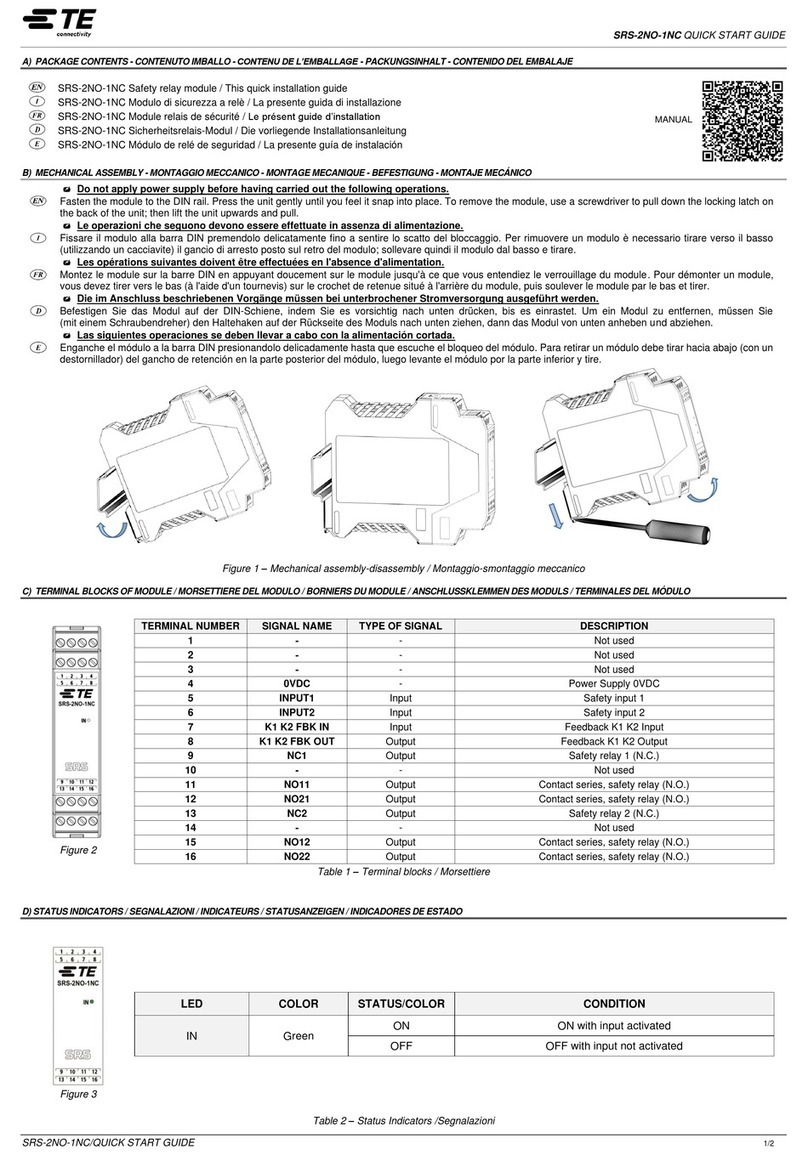
TE Connectivity
TE Connectivity SRS-2NO-1NC Quick installation guide

Velleman
Velleman VMA332 user manual

Westinghouse
Westinghouse SBF-1 Installation, operation & maintenance instructions
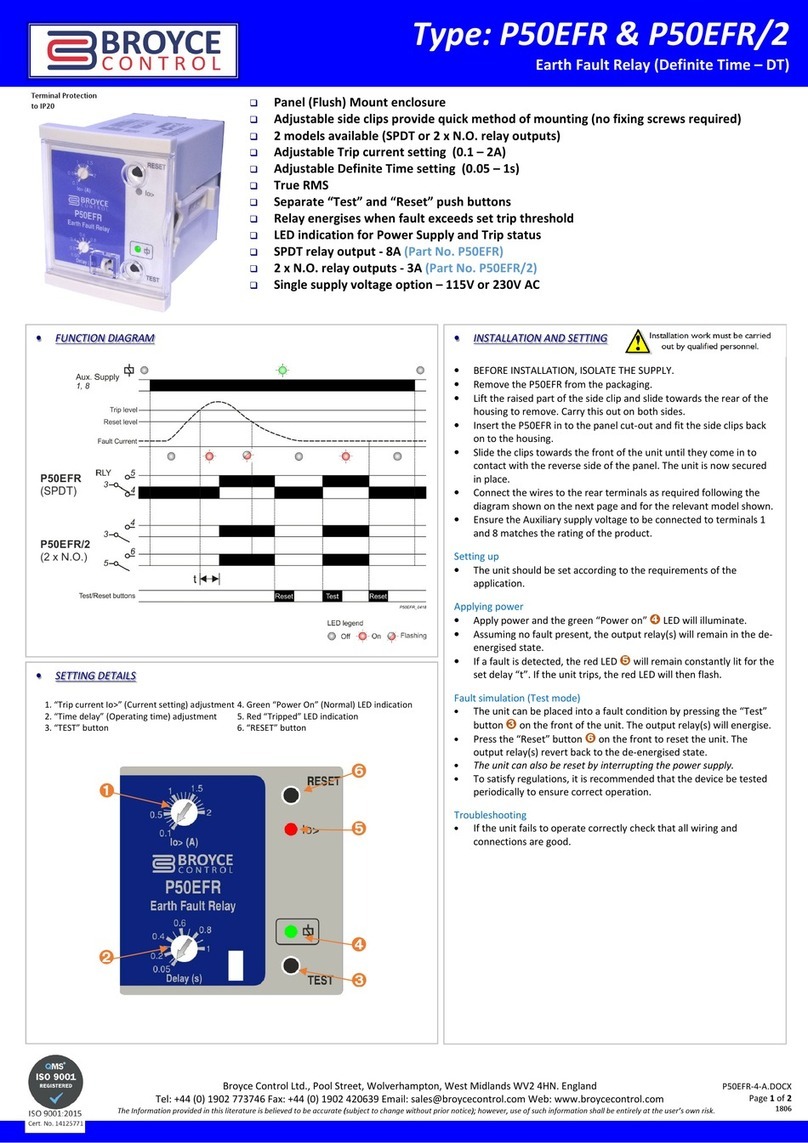
Broyce Control
Broyce Control P50EFR installation instructions
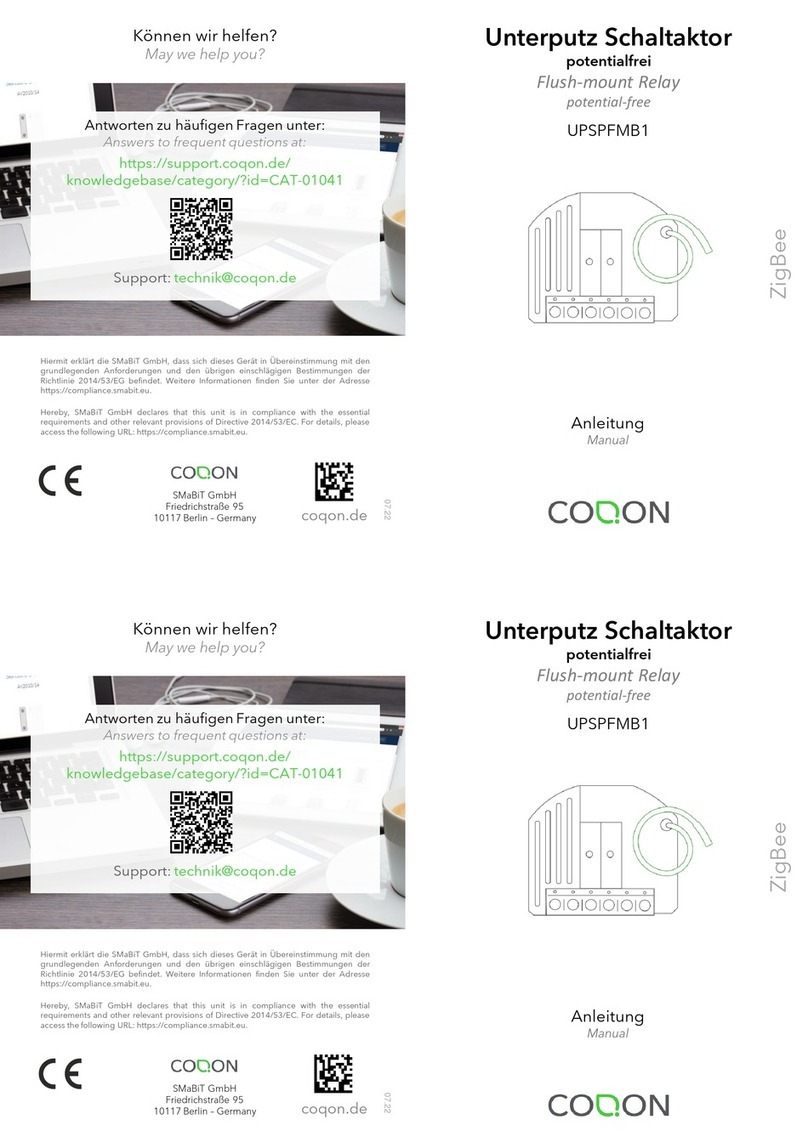
COQON
COQON UPSPFMB1 manual

NIVELCO
NIVELCO NITIME JEL-111 user manual
